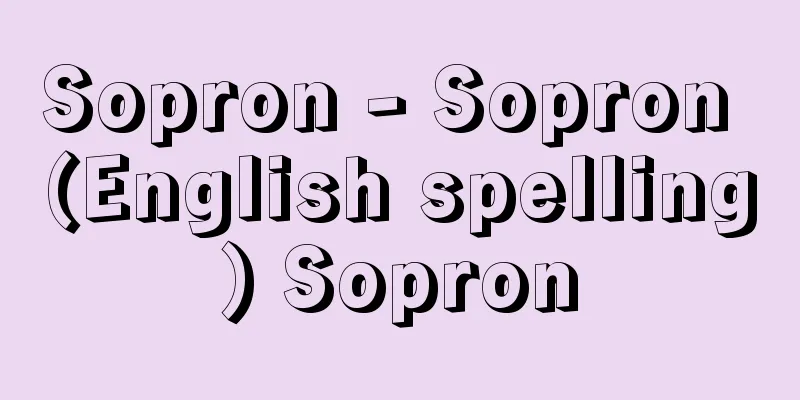Parkinson's syndrome - parkinsonism

|
A general term for Parkinson's disease and conditions very similar to it, which are characterized by extrapyramidal symptoms such as muscle rigidity, tremor, and bradykinesia (sluggish and limited movement), or it refers exclusively to conditions similar to Parkinson's disease. [Shinichiro Ebihara] DefinitionIn 1817, British physician James Parkinson (1755-1824) was the first to identify a disease of unknown cause characterized by three symptoms: muscle rigidity, tremor, and hypokinesia. He called it paralysis agitans, but today it is more commonly called Parkinson's disease. Later, it was discovered that conditions very similar to this disease were also caused by lethargic encephalitis, cerebral arteriosclerosis, poisoning with drugs, carbon monoxide, manganese, cyanide compounds, brain tumors, head trauma, syphilis, and other conditions. Parkinson's syndrome or parkinsonism is a condition in which symptoms such as muscle rigidity, tremor, and hypokinesia appear in various combinations, including these. Paralysis agitans of unknown cause (Parkinson's disease) may or may not be included in this category. From the perspective of regarding the whole as Parkinson's syndrome, it can be divided into essential (idiopathic) and symptomatic (secondary). Of these, the most common is essential Parkinson's syndrome, or Parkinson's disease, whose prevalence is estimated to be 100-150 people per 100,000 in Japan and 150-200 in Europe and the United States. [Shinichiro Ebihara] Symptoms and TreatmentParkinson's disease generally progresses slowly, eventually requiring assistance and often resulting in a life of bed rest. However, there are large individual differences in how the disease progresses. At present, the cause is unknown, and there is no treatment that can stop the progression of the disease or cure it fundamentally, but symptomatic treatments such as drug therapy are used to slow the progression and improve symptoms. The Japanese Society of Neurology has presented treatment guidelines, and as of 2009, L-dopa and dopamine agonist are mainly used as the basic drugs. L-dopa in particular is a treatment that replenishes the dopamine that is lacking in the brain (striatum), and has the most remarkable effect, and is used for a long time as the main axis of Parkinson's disease treatment. However, the effectiveness of L-dopa also decreases when taken for a long period of time, and it can cause side effects such as mental symptoms and involuntary movements. Although drugs are effective, they also have side effects and contraindications, so it is necessary to use them appropriately according to each case. In contrast to Parkinson's disease of unknown etiology as mentioned above, the course and treatment of symptomatic Parkinson's syndrome varies depending on the disease considered to be the cause. Among symptomatic Parkinson's syndrome (parkinsonism), the most important are drug-induced parkinsonism, which is caused by drugs, and cerebrovascular parkinsonism, which is triggered by cerebrovascular disorders. Medications that cause Parkinson's disease-like conditions include blood pressure lowering drugs (rauwolfia preparations, α-methyldopa), drugs used to suppress nausea and vomiting or for sedation (phenothiazine preparations), drugs commonly used for gastrointestinal disorders (sulpiride, metoclopramide), and psychiatric drugs (phenothiazine and butyrophenone preparations). In patients who have been using such drugs for a long time and have parkinsonism, in most cases the symptoms improve when the drug considered to be the cause is stopped. Anticholinergic drugs are more effective than L-dopa in terms of drug therapy. Parkinsonism, which is presumed to be caused by cerebrovascular disease, may develop as a result of a stroke, but there may also be cases where the disease begins without any obvious stroke, similar to ordinary Parkinson's disease, and this is also called arteriosclerotic parkinsonism. Symptoms appear after the patient is 60 years old or older, and are often accompanied by high blood pressure, memory loss, and mild paralysis of the limbs, so the medication used for Parkinson's disease is not very effective. Parkinson's syndrome caused by encephalitis lethargica has become rare, as more than 50 years have passed since encephalitis lethargica became prevalent. [Shinichiro Ebihara] Supplementary NoteParkinson's disease is designated as a specific disease (incurable disease), but since 2003, it has been classified as a specific disease under the name of Parkinson's disease-related diseases, along with progressive supranuclear palsy and corticobasal degeneration. [Editorial Department] [Reference] | | | | | | |Source: Shogakukan Encyclopedia Nipponica About Encyclopedia Nipponica Information | Legend |
|
錐体(すいたい)外路症状である筋硬直、振戦(しんせん)(ふるえ)、寡動(動きがにぶく少ない)を特徴とするパーキンソン病とそれにきわめて類似した状態の総称、あるいはパーキンソン病に類似した状態だけをさす。 [海老原進一郎] 定義1817年、イギリスの医師パーキンソンJames Parkinson(1755―1824)は、筋硬直、振戦、寡動の三つの症状で特徴づけられる原因不明の病気を初めて明らかにし振戦麻痺(まひ)とよんだが、今日ではパーキンソン病といわれることのほうが多い。これに対してその後、この病気にきわめて類似した状態が、嗜眠(しみん)性脳炎、脳動脈硬化症、薬物・一酸化炭素・マンガン・シアン化合物などの中毒、脳腫瘍(しゅよう)、頭部外傷後、梅毒などによっても引き起こされることがわかってきた。これらを含めて筋硬直、振戦、寡動などの症状が種々の組合せで出現する状態がパーキンソン症候群またはパーキンソニズムである。原因不明の振戦麻痺(パーキンソン病)は、このなかに含まれる場合と含まれない場合がある。全体を一括してパーキンソン症候群とする立場では、パーキンソン症候群は本態性(特発性)と症候性(二次性)に分けられる。これらのうち、もっとも頻度が高いのは本態性パーキンソン症候群、すなわちパーキンソン病で、その有病率は日本では人口10万当り100~150人とされており、欧米では150~200人とされる。 [海老原進一郎] 症状と治療パーキンソン病は一般にゆっくりと進行し、やがて介助が必要となり、臥床生活に至ることが多い。ただし、病状の進み方には大きな個人差がある。現時点では、原因は不明であり、病期の進行を止めたり根本的に治癒させる治療法はないが、進行を遅らせたり症状を改善する目的の薬物療法など対症療法が行われる。日本神経学会による治療ガイドラインが提示されており、2009年現在、おもにL-ドーパとドーパミンアゴストが基本薬として用いられる。とくにL‐ドーパは、脳内(線状体)で不足しているドーパミンを補充する治療法で、もっとも顕著な効果がみられ、パーキンソン病治療の主軸として長期にわたって用いられる。しかし、L‐ドーパも長期間服用していると効果が落ち、精神症状や不随意運動などの副作用を起こすこともある。薬剤は、効果がある反面、副作用や禁忌もあるので、それぞれの場合に応じた使い分けが必要である。 前述のような原因不明のパーキンソン病に対して、症候性パーキンソン症候群では病気の経過や治療法が、原因とみなされる病気によってさまざまである。症候性パーキンソン症候群(パーキンソニズム)のうち、とくに重要なものは薬物によって引き起こされる薬剤性パーキンソニズムと、脳血管障害が引き金となって発病する脳血管性パーキンソニズムである。パーキンソン病類似の状態を引き起こす薬としては血圧を下げる薬(ラウオルフィア製剤、α‐メチルドパ)、悪心や嘔吐(おうと)を抑えたり鎮静のために使う薬(フェノチアジン系製剤)、消化器疾患によく使われる薬(スルピリド、メトクロプラミド)、精神科で使う薬(フェノチアジン系やブチロフェノン系製剤)などがあげられる。このような薬を長期間連用してパーキンソニズムがみられる患者では、たいていの場合、原因とみなされる薬の投薬をやめれば軽快する。薬物療法としてはL‐ドーパよりも抗コリン剤のほうが効果がある。 脳血管障害が原因と推定されるパーキンソニズムでは、脳卒中の発作が契機となって発病するものもあるが、明らかな脳卒中発作がなくて普通のパーキンソン病と同様に、いつとはなしに病気が始まってくるものもあり、動脈硬化性パーキンソニズムともよばれる。60歳以上の高齢になってから症状が現れ、高血圧や記憶障害、軽い四肢の麻痺を伴っていることが多く、パーキンソン病に使う治療薬の効果はあまり期待できない。また、嗜眠性脳炎によるパーキンソン症候群は、嗜眠性脳炎が流行して50年以上を経過した現在、ほとんどみる機会はなくなった。 [海老原進一郎] 補説なお、パーキンソン病は特定疾患(難病)指定されているが、2003年度(平成15)より、進行性核上性麻痺、大脳皮質基底核変性症とともに、パーキンソン病関連疾患という名称のもとに特定疾患分類されている。 [編集部] [参照項目] | | | | | | |出典 小学館 日本大百科全書(ニッポニカ)日本大百科全書(ニッポニカ)について 情報 | 凡例 |
Recommend
Anna O. - Anna O.
A 21-year-old female patient treated by the Vienne...
Cooley, D.
...From then until 1984, Shumway performed over 3...
Geisha
An old and popular name for geisha (geigi). In th...
Shinjuku Gyoen
This park straddles Shinjuku and Shibuya wards in ...
xenon
Xe. Atomic number 54. Electron configuration [Kr]...
Eastern Region Transmission Catalog - Touki Dento Mokroku
A catalog of Buddhist books from the Heian period....
Anatexis (English spelling)
There are different interpretations of this term. ...
Bereaved family bonds - Izokukokusai
...In Japan, many bonds were issued in the early ...
Kibo (English spelling) gui-fang; kuei-fang
"Hitsu" means a box. It refers to a prop...
Canasta (English spelling)
This card game was invented in Uruguay in the late...
Juvenile Prosecution - Shounen Shinpan
A trial held in a family court for a juvenile del...
Superior - Chojo
〘noun〙① To be older. To be of a higher rank. Also,...
Chemical kinetics
…Reaction rates are generally expressed as the ra...
Craig
British stage designer and director. His mother wa...
Phosphate ore (Rinkou (English spelling) phosphorite)
A mineral whose main component is phosphorus (P). ...









